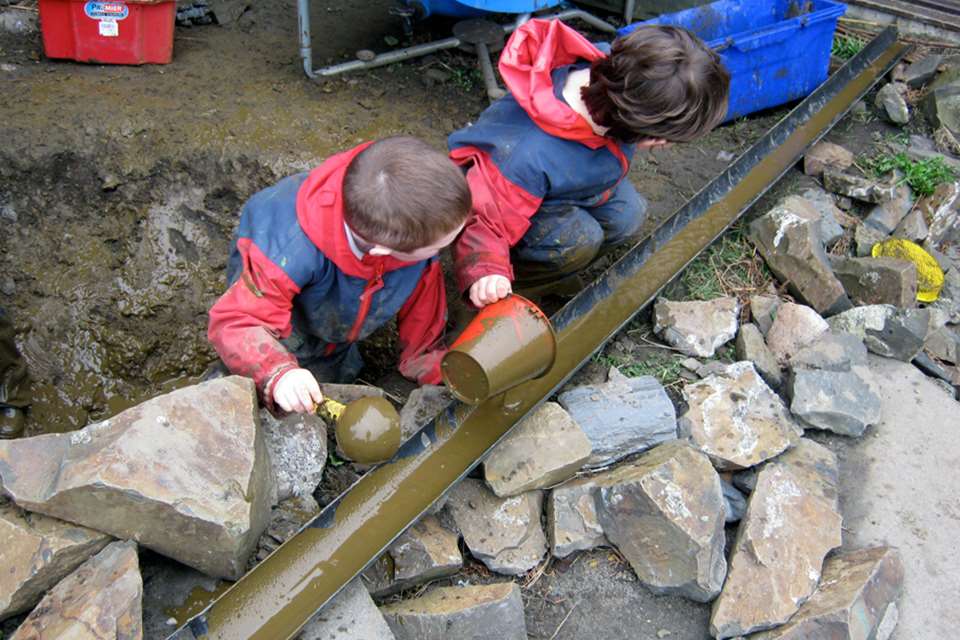EYFS Activities: We've explored...a hole
Annette Rawstrone
Monday, February 20, 2017
How one child’s interest in digging led to a whole setting getting involved. By Annette Rawstrone

A patch of muddy ground, a spade and a child who wanted to dig and dig all the way to Australia. One boy’s interest, supported by an early years practitioner, escalated into a whole-setting exploration at Oakey Dokeys Pre-school in Great Oakley, Essex. It lasted for around eight weeks with children and practitioners digging, investigating underground, designing and building bridges, and ultimately filling in the large hole.
‘All our planning is organic and done on the spot, inspired by what the children are doing and their interests, so when Sid decided that he wanted to do some digging in a muddy area of our garden, I helped him,’ says manager Shirley Funnell. ‘We ended up spending the whole session outside in the garden digging. We took it in turns to dig and occasionally I’d ask him if he wanted to stop, but he was enthusiastic to continue despite it being a rainy day.’
As they dug, Ms Funnell and Sid, who was almost four years old, discussed what they may find in the hole. He said that once they got to the bottom, they may find Australia, so they discussed what animals live there.
‘We found lots of worms while we were digging. We looked at how they moved and measured them to put them in order from biggest to smallest. Later on we made a bug hotel with the worms so that children could watch them burrow in the earth,’ explains Ms Funnell. ‘The rich language that Sid used while we were digging was excellent. At one point he enthusiastically declared, “We’re excavating now”.’
The rain started to collect in the bottom of the hole so they also talked about it going in and where it was disappearing to. They spoke about evaporation and also considered different ways that they could cover the hole to prevent water from entering.
‘We kept egging each other to go on digging and go deeper. The excitement and communication we had was excellent. We really bonded over the hole, it was brilliant,’ explains Ms Funnell. The hole was over a foot deep by the time they stopped digging – big enough for Sid to stand inside.
JOINING IN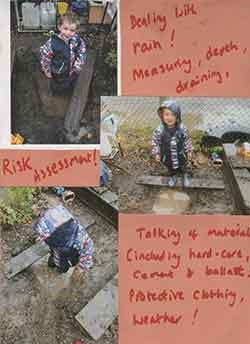 Staff were unsure what to do with the large hole, but other children caught on to Sid’s enthusiasm for digging, and they wanted to join in. They started to dig their own smaller holes and were keen to look at the original hole, climb into it and see how high up their bodies it came.
Staff were unsure what to do with the large hole, but other children caught on to Sid’s enthusiasm for digging, and they wanted to join in. They started to dig their own smaller holes and were keen to look at the original hole, climb into it and see how high up their bodies it came.
Staff spoke to them about how to get in and out of the hole safely. They discussed the risk of people falling into the hole and children suggested making warning signs. They used their literacy skills to produce the signs, which were laminated and fastened on to sticks to put in the ground around the hole. Cones and tape were also used to cordon off the area.
‘Thankfully, the soil was very heavy and held together well, but as interest in the hole continued, staff risk-assessed it every day to ensure it was safe. There was also always a practitioner near to the hole to ensure younger children didn’t fall in,’ says Ms Funnell. ‘We believe that children need to learn through taking their own risks, so if we’d ever felt that there was a danger we would have discussed how to make it safe with the children.’
Children used planks of wood to cover their holes, which led on to them developing an interest in bridges. They used the iPad to look up plans of bridges on the internet.
They looked in particular at the Severn Bridge, a suspension bridge crossing from England to Wales, and London’s Tower Bridge, an ornate bascule and suspension bridge, with children fascinated by how its deck can be raised in order to allow boats to pass through.
‘Some children drew their own bridge designs, while others wanted to get stuck in straight away and construct their bridges,’ she says. ‘We used planks of wood and crates to build a bridge over the hole.’
Having a bridge spanning the large hole inspired children to draw roads leading up to it with chalk. They walked carefully, rode bikes or pushed wheelbarrows along the roads and over the bridge. ‘We continued to talk about risk, such as using our “indoor legs” to walk over the bridge. It was lovely to see children helping to support others to walk over it by holding hands,’ says Ms Funnell.
‘At one point, I was a troll under the bridge, which led to us acting out the story of The Three Billy Goats Gruff and also reading the book.’
EXPERIMENTING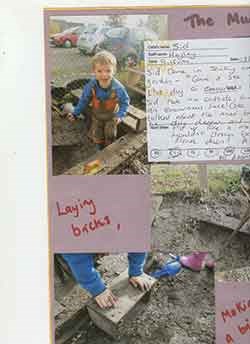 Children were excited to go to the hole each day and Sid was very proud to show his mum his work. Staff gave him photographs of the hole to take home and share with his family. Many other parents also took an interest in the hole and the excitement that it was creating throughout the pre-school.
Children were excited to go to the hole each day and Sid was very proud to show his mum his work. Staff gave him photographs of the hole to take home and share with his family. Many other parents also took an interest in the hole and the excitement that it was creating throughout the pre-school.
The hole became a focus for scientific investigations. Children made predictions and experimented with what would sink or float in the pool of water gathered in the hole. They used objects ranging from stones and paper boats to paintbrushes and milk bottle tops.
The water got a new look when children put powder paint in to see what colour they could make it, resulting in a blue pool – ‘Some of the children went home looking like Smurfs that day,’ recalls Ms Funnell.
One cold morning, children were thrilled to see that the water in the hole had frozen hard overnight. They explored how to crack the ice, starting by tapping it tentatively with their feet and prodding it with sticks. Practitioners offered resources such as salt and hammers.
‘The children persevered with trying to crack the ice for some time until one child got frustrated and decided to try to dig it out. He found a big spade and whacked the ice, which had the desired result,’ she says.
Inspired by Sid thinking that he may dig down to Australia, children researched the indigenous creatures that they would find there, such as kangaroos and koalas, and they also read Mole in a Hole and talked about moles, rabbits and foxes that like to burrow underground. Talking about things that tunnel underground led some children to look at the London Underground and the network of train lines that travel under the city.
FILLING IN
‘After quite a number of weeks we felt that it was time to start thinking about filling in the hole because the water gathered in the bottom of it was getting really smelly,’ says Ms Funnell. ‘So we talked to Sid to get his opinion and he suggested using ballast to fill it in. We decided to use this and stones and thought about how much we’d need to fill the hole.’
Ms Funnell bought six bags of ballast and Sid acted as project manager for the job of closing up the hole. He directed children as they transported the ballast in wheelbarrows across the outdoor area, constructed a ramp to go down into the hole and used spades to spread out the ballast.
‘The children took it in turns to use the wheelbarrows. It took two children to push them because they were so heavy,’ she says. ‘It took quite some time and a lot of stones and ballast to fill the hole and there’s still a dip marking the site. It was amazing what we managed to do with a simple hole. I was a little sad myself when it had gone.’
BOOK CORNER
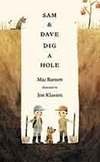 Sam and Dave Dig a Hole by Mac Barnett and Jon Klassen
Sam and Dave Dig a Hole by Mac Barnett and Jon Klassen
Sam and Dave are on a mission to find something spectacular, so start digging, and digging. But will they hit treasure? A deadpan tale full of visual humour by an award-winning duo.
One Mole Digging a Hole by Julia Donaldson and Nick Sharratt
Join in and count along with the animals who are all busy lending a hand in the garden.
Mole in a Hole by Lesley Sims and David Semple
A rhyming story about builder Mole.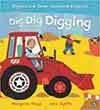
Postman Pat and the Hole in the Road by John Cunliffe and Stuart Trotter
Pat and Alf are determined not to let a small hole disrupt their day.
Dig Dig Digging by Margaret Mayo and Alex Ayliffe
Diggers and tractors, cranes and bulldozers do the heavy lifting in this classic featuring fun, rhyming text and vibrant artwork.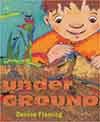 Going underground
Going underground
Underground by Denise Fleming
Exploring the secrets of the creatures that live underground.
The Street Beneath My Feet by Charlotte Gullian and Yuval Zommer
Out next month, this foldout book has the ground beneath the city on one side and the ground beneath the countryside on the reverse.
Bridges Here to There and Me to You by Cheryl Keely and Celia Krampien
Here to There and Me to You by Cheryl Keely and Celia Krampien
This book explores bridges in their various forms, and reminds us of their main purpose.
The Three Billy Goats Gruff by Nick Sharratt and Stephen Tucker
Lift the flaps and look out for pop-up surprises.
Australia
 Josephine Wants to Dance by Jackie French and Bruce Whatley
Josephine Wants to Dance by Jackie French and Bruce Whatley
A dancing kangaroo takes centre stage in this picture book classic.
Over in Australia: Amazing Animals Down Under by Marianne Berkes and Jill Dubin
The uniqueness of Australia’s wildlife.
For something different
The Hole Story by Paul Bright and Bruce Ingman
A surreal story about creatures evicted from their holey cheese home.



